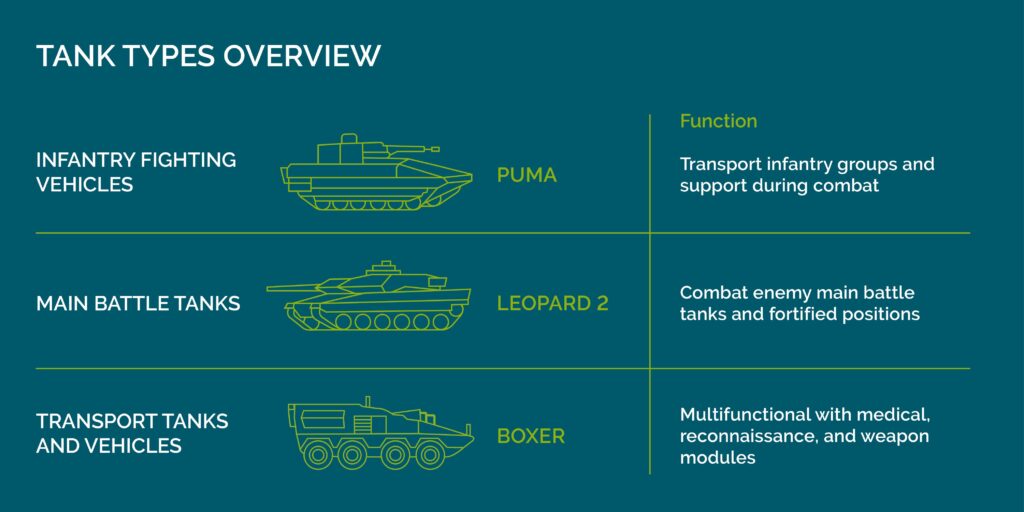Leopard, Puma, and Boxer
Everything You Need to Know about the Tanks Used by the German Armed Forces
Not only are they dangerous predators, they also lend their names to the German Armed Forces’ systems – during military operations, the Leopard, Puma, and Boxer are distantly reminiscent of their animal counterparts. Our overview illustrates what makes the individual tanks stand out and what distinguishes them from one another:
The German Armed Forces use the Leopard 2 as what is known as a main battle tank. Just like the predator, it is characterized by a high degree of mobility and power, made possible by its strong armor, large-caliber cannon in a gun turret that can be rotated 360 degrees, and – a crucial difference from the transport tanks – its caterpillar tracks. The Leopard 2 is used to combat enemy main battle tanks and fortified positions. Among other systems, VINCORION’s on-board power supply, large dust blower, and gun turret and weapon stabilization systems ensure the tank’s smooth operation. Other well-known main battle tanks include the Challenger 2 (UK), M1 Abrams (USA), Leclerc (France), and K2 Black Panther (South Korea).
Infantry fighting vehicles such as the Puma and its predecessor, the Marder, are also deployed on the front line, but with lighter armor. Their job is to transport infantry groups – six to ten people in addition to the vehicle’s own crew – and provide support during combat. Infantry fighting vehicles are equipped with lighter, rapid-fire machine guns and, increasingly, anti-tank guided missiles. A special feature of the Puma is that it is the first infantry fighting vehicle with a 170 kW power system. The state-of-the-art on-board power supply with its compact starter generator, which is located between the HPD engine and the transmission, is also a solution developed by VINCORION, as are the gun turret and weapon stabilization systems. We are currently optimizing the Puma’s power electronics.
Did you know…
that other countries also draw inspiration from the animal kingdom and even mythical creatures? The Chinese fighter-bomber Xian JH-7, for example, is named the “Flying Leopard,” and the Chengdu J-10 combat aircraft the “Vigorous Dragon.”
Transport tanks such as the Fox or transport vehicles such as the Boxer have much weaker armor, but are faster and more maneuverable. Another distinguishing feature is that they do not run on tracks, but instead have wheels. Transport tanks are also characterized by their multifunctionality. With medical, reconnaissance, weapons, and other mission modules, the systems are equipped to suit the specific application. VINCORION also supplies the on-board power supply for the Boxer.

Picture source: The Ad Store GmbH
In addition, there are a number of specialized armored vehicles that fulfill a special mission in the German Armed Forces.
The “Buffalo” or Bergepanzer 3 A1 is a real behemoth of an armored recovery vehicle (ARV) with a combat weight of 55.3 tons and 1,500 hp. Its three-person crew clears obstacles and is even capable of recovering immobilized vehicles under fire. To do so, the Buffalo’s crane system can lift up to 30 tons. The chassis is structurally identical to the Leopard 2 main battle tank. In addition to the on-board power supply, VINCORION supplies the welding controller for the equipment installed that the Buffalo uses to carry out repairs.
The Iguana bridge-laying tank is gradually replacing its predecessor, the Beaver. Its chassis is also based on the Leopard 2, but the turret has been replaced by a high-speed armored bridge with a laying system. This allows the Iguana to build a 26-meter crossing within five minutes. All of the German Armed Forces’ heavy combat vehicles can use the bridges due to their high load-bearing capacity of more than 70 tons, enabling them to cross small rivers or obstacles.
Equipped with an excavator arm and a scraper blade with ripper teeth for hard ground, the Badger pioneer tank digs through the soil just as skillfully as its animal counterpart. It performs clearing, dredging and recovery work, prepares emplacements for battle tanks, and makes impassable terrain passable. Even bodies of water can’t stop it – the Badger can travel underwater at a depth of up to 4 meters.
Nimble and light, but not to be underestimated, the Wiesel armored weapons carrier (AWC) comes in a number of configurations for reconnaissance, engaging enemy targets, or providing medical care. Its modest size earned it the nickname “Pocket Tank.” Although its tracks are as narrow as a notebook, the Wiesel 1 AWC packs some serious firepower and can even pose a threat to full-sized main battle tanks. The air-transportable vehicle is particularly used by the German Army’s mountain troops and paratroopers.
Picture source header (tank in sunrise): cla78 /iStock
Everything You Need to Know about the Tanks Used by the German Armed Forces